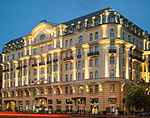Warsaw

Warsaw (Polish: Warszawa, [varˈʂava] (listen)), officially the Capital City of Warsaw, is the capital and largest city of Poland. The metropolis stands on the River Vistula in east-central Poland and its population is officially estimated at 1.8 million residents within a greater metropolitan area of 3.1 million residents, which makes Warsaw the 7th most-populous capital city in the European Union. The city area measures 517 km2 (200 sq mi) and comprises 18 boroughs, while the metropolitan area covers 6,100 km2 (2,355 sq mi). Warsaw is an alpha− global city, a major cultural, political and economic hub, and the country's seat of government. Its historical Old Town was designated a UNESCO World Heritage Site. Warsaw traces its origins to a small fishing town in Masovia. The city rose to prominence in the late 16th century, when Sigismund III decided to move the Polish capital and his royal court from Kraków. Warsaw served as the de facto capital of the Polish–Lithuanian Commonwealth until 1795, and subsequently as the seat of Napoleon's Duchy of Warsaw. The 19th century and its Industrial Revolution brought a demographic boom which made it one of the largest and most densely-populated cities in Europe. Known then for its elegant architecture and boulevards, Warsaw was bombed and besieged at the start of World War II in 1939. Much of the historic city was destroyed and its diverse population decimated by the Ghetto Uprising in 1943, the general Warsaw Uprising in 1944 and systematic razing. Warsaw is served by two international airports, the busiest being Warsaw Chopin and the smaller Warsaw Modlin intended for low-cost carriers. Major public transport services operating in the city include the Warsaw Metro, buses, urban-light railway and an extensive tram network. In 2012, the Economist Intelligence Unit ranked Warsaw as the 32nd most liveable city in the world. In 2017, the city came 4th in the "Business-friendly", 8th in "Human capital and life style" and topped the quality of life rankings in the region. The city is a significant centre of research and development, business process outsourcing, and information technology outsourcing. The Warsaw Stock Exchange is the largest and most important in Central and Eastern Europe. Frontex, the European Union agency for external border security as well as ODIHR, one of the principal institutions of the Organization for Security and Cooperation in Europe have their headquarters in Warsaw. Jointly with Frankfurt and Paris, Warsaw features one of the highest number of skyscrapers in the European Union, while Varso Place is the tallest building in the EU as of 2022.The city hosts the Polish Academy of Sciences, National Philharmonic Orchestra, University of Warsaw, the Warsaw University of Technology, the National Museum, Zachęta Art Gallery and the Warsaw Grand Theatre, the largest of its kind in the world. The reconstructed Old Town, which represents examples of nearly every European architectural style and historical period, was listed as a World Heritage Site by UNESCO in 1980. Other main architectural attractions include the Royal Castle and the iconic King Sigismund's Column, the Wilanów Palace, the Palace on the Isle, St. John's Cathedral, Main Market Square, as well as numerous churches and mansions along the Royal Route. Warsaw possesses thriving arts and club scenes, gourmet restaurants and large urban green spaces, with around a quarter of the city's area occupied by parks.
Excerpt from the Wikipedia article Warsaw (License: CC BY-SA 3.0, Authors, Images).Warsaw
Aleje Jerozolimskie, Warsaw Śródmieście (Warsaw)
Geographical coordinates (GPS) Address Nearby Places Show on map
Geographical coordinates (GPS)
| Latitude | Longitude |
|---|---|
| N 52.23 ° | E 21.011111111111 ° |
Address
Centrum 06
Aleje Jerozolimskie
00-692 Warsaw, Śródmieście (Warsaw)
Masovian Voivodeship, Poland
Open on Google Maps










